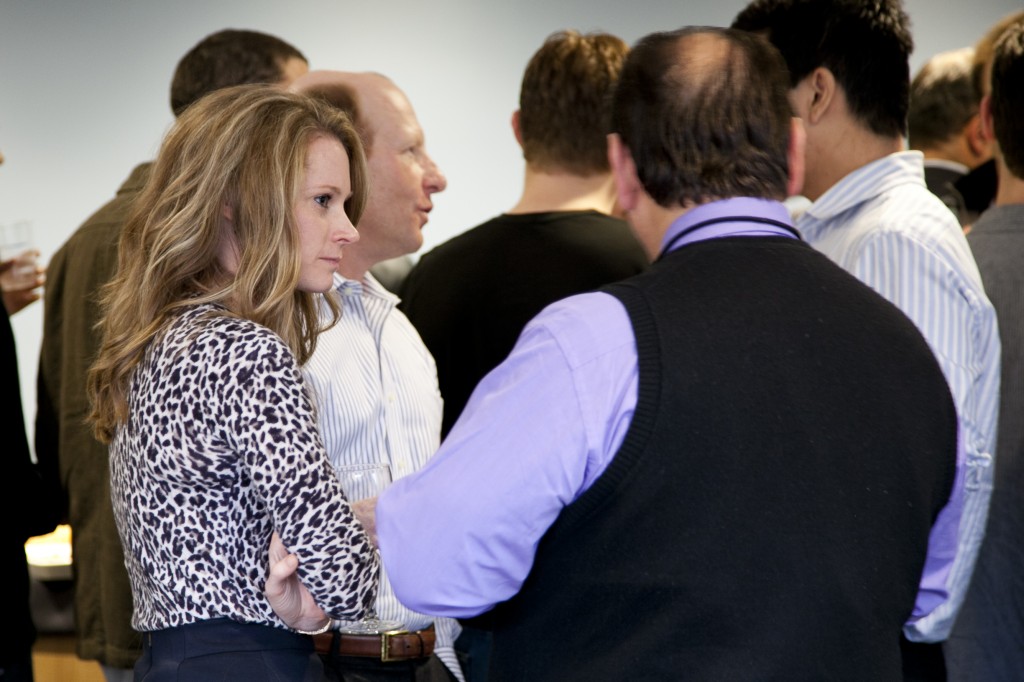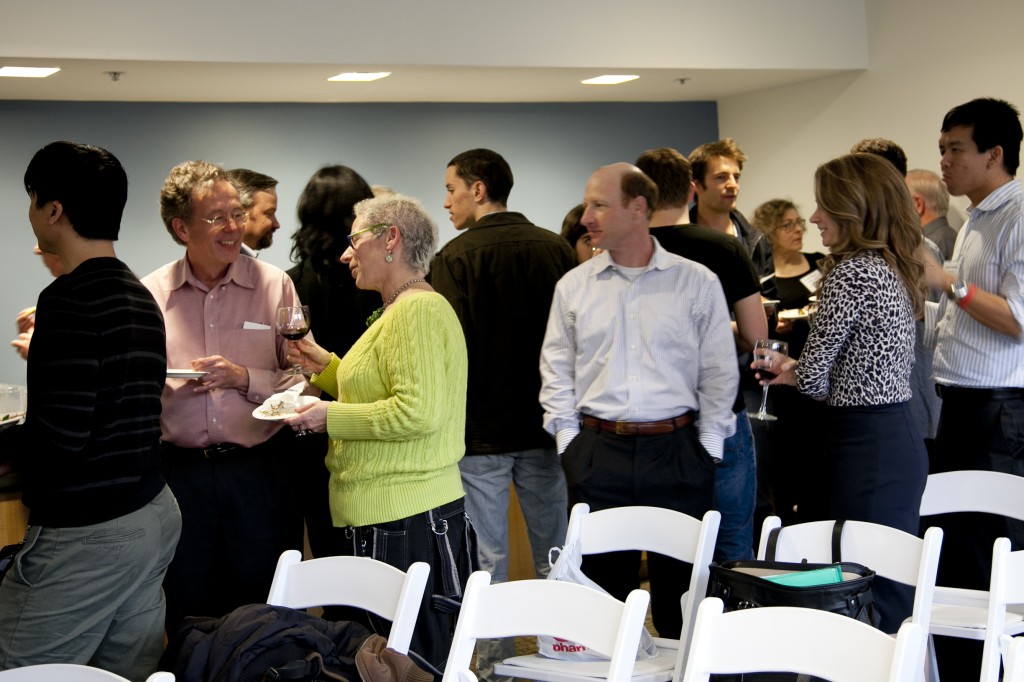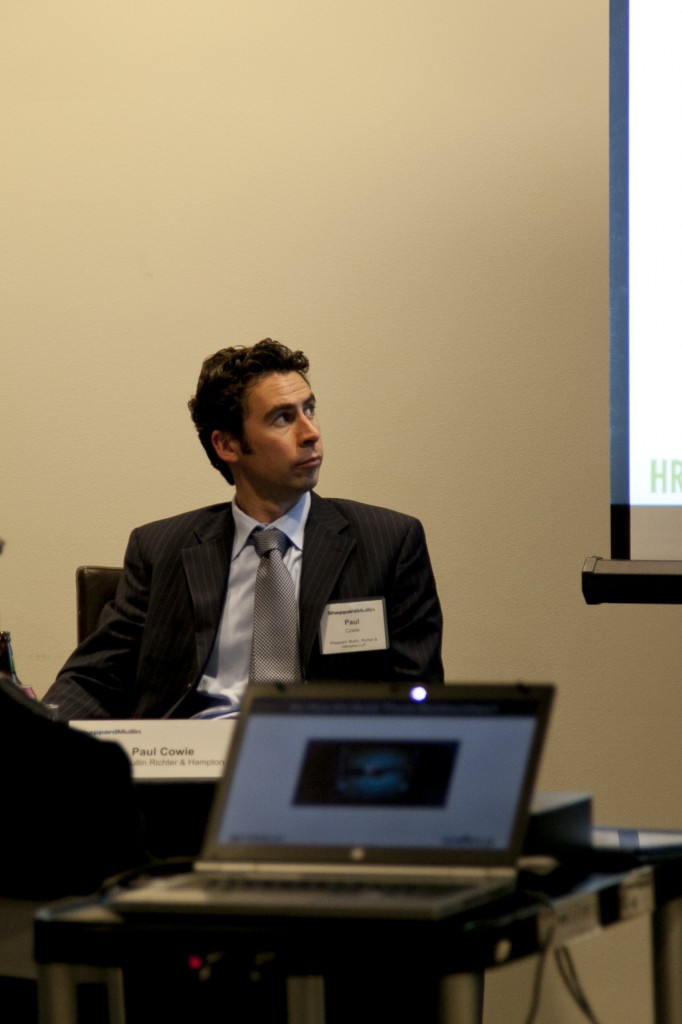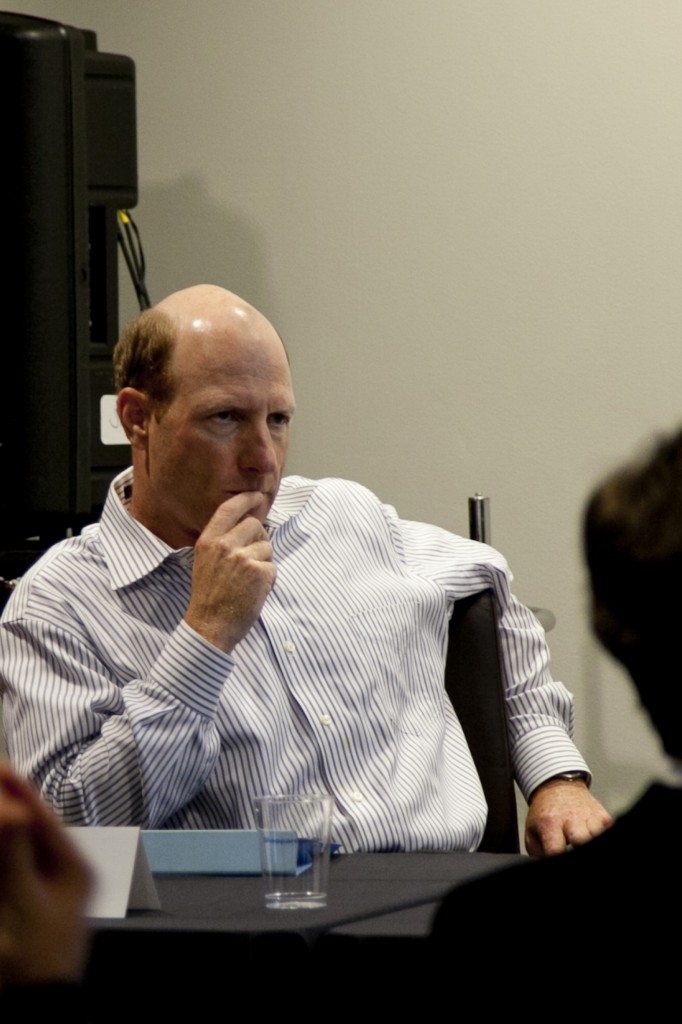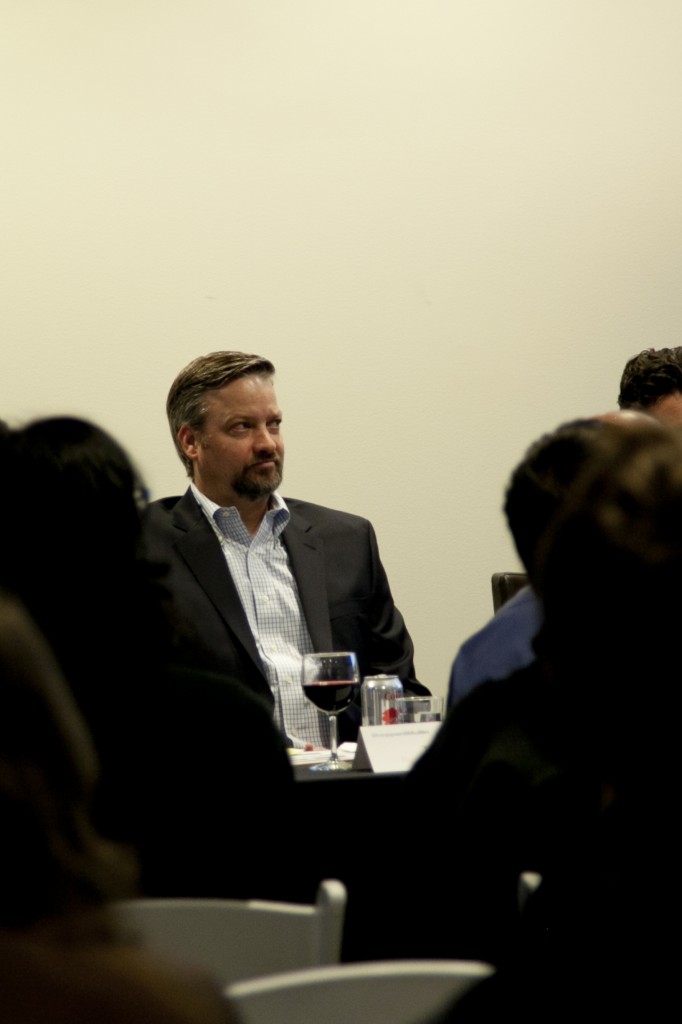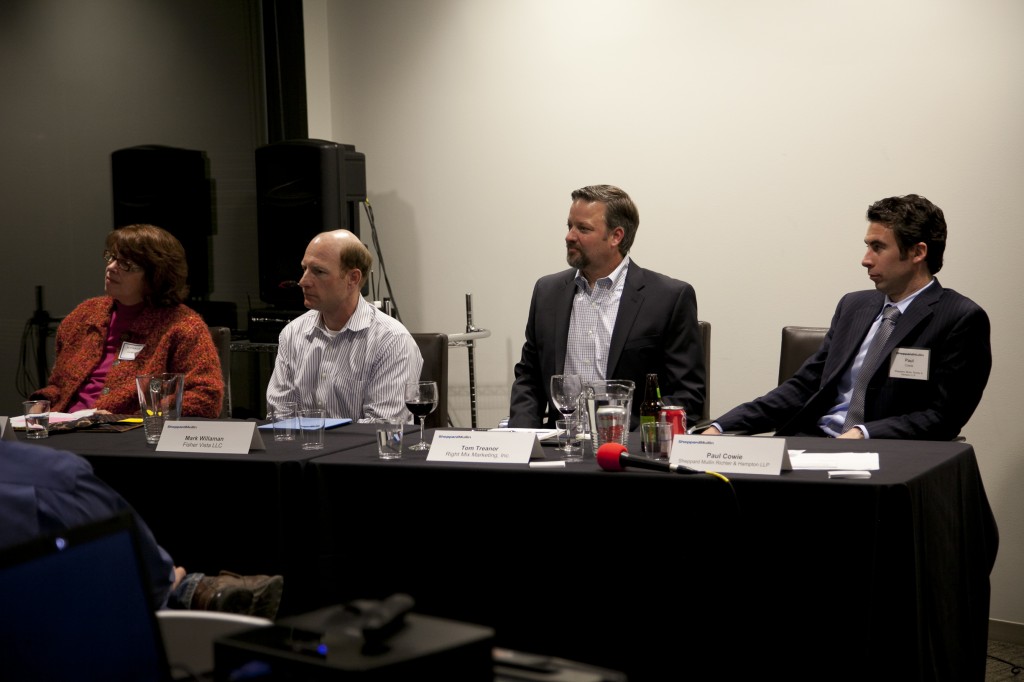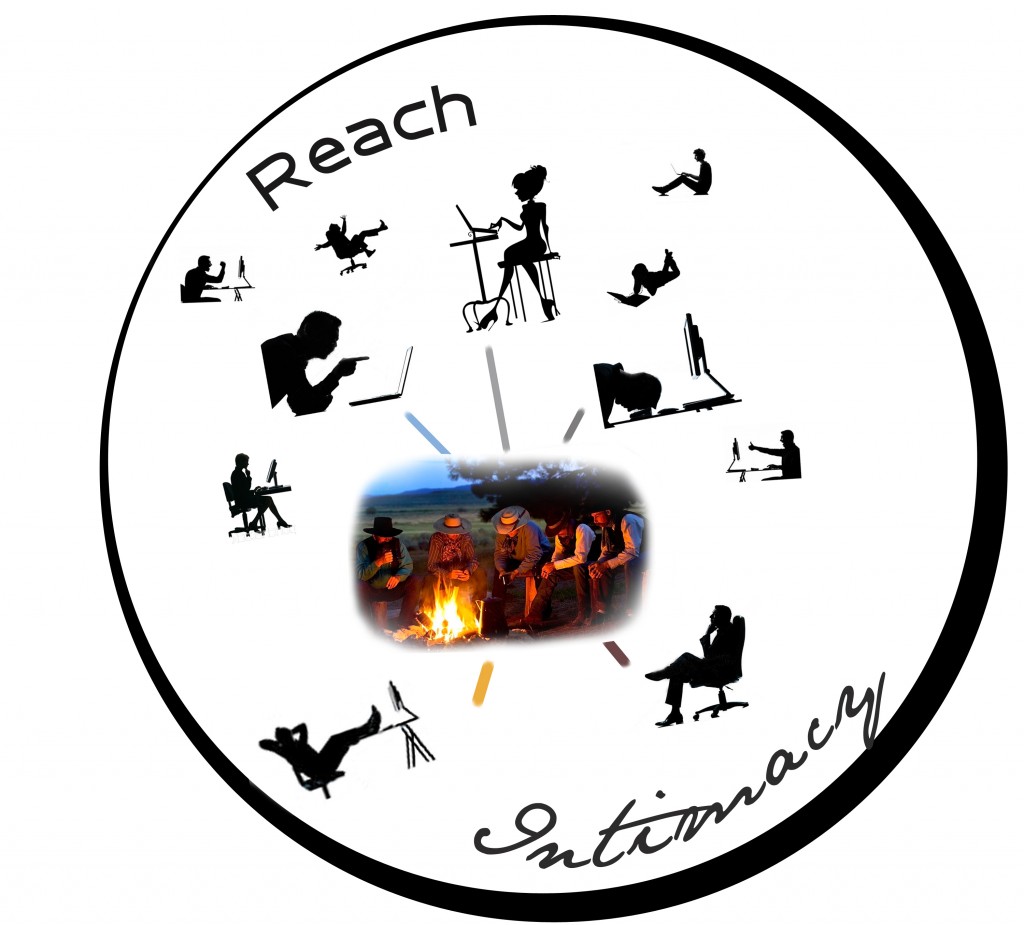social media
MAR 20th 2013 (Recap): Achieving Intimacy AND Reach Through Social Media
On March 20th, the Silicon Valley Innovation Institute (SVII) had a gathering on the topic of “Achieving Intimacy AND Reach Through Social Media,” hosted by the Palo Alto office of Sheppard Mullin Law Associates, where we talked about social media marketing.
It was a vigilant meeting:
That was a joke. But we were definitely treated to some fine fare by our generous hosts at Shepperd Mullin:
The goal was to see if social media allows you to have intimacy and reach at the same time. Traditional marketing and advertising has had great mass-market reach through things like TV, radio, and newspapers, but it hasn’t had the personal connection, therefore losing a lot of the impact. This is the reason that advertising has always been a fairly inefficient medium. With the advent and ubiquity of social media, however, the possibility is out there that advertising can be much more efficient and effective through the use of personalization. While the consensus was that yes, such intimacy (and effectiveness) is possible, there was still some debate over what that actually means or whether that was even a good thing.
There was debate over whether personalized advertising can actually be considered as intimacy. One of the definitions proposed by an audience participant was that a relationship is intimate when people don’t feel the need to emotionally hide themselves. That’s a good discrete definition of intimacy (which can be hard to achieve in social media). However, on a more gradual scale, you could say that a relationship gets more intimate as it gets less formal and more familiar, which is certainly something that can be achieved through today’s social media. The 2012 Obama presidential campaign is famous for having very informal and “chatty” email titles. This is something that they did after testing showed that the more informal emails that looked more like emails from friends than campaign emails had a much higher response rate in terms of donations per email received. The natural follow-up question is whether or not you actually want to become more familiar with your customers and the people you buy from. From a business perspective, the answer is almost always yes, because people who feel more comfortable with you or your company are more likely to buy from you.
Another related question is whether or not this demolishes the barrier between professional life and personal life. Some people really do like knowing details about artists that have nothing to do with their art (in fact, it appears that the trend is going in that direction) and other people don’t. This is one of the many reasons that you need to listen to your audience/customers/constituencies. Other factors to consider are your personality type and what kind of business you’re in. Our incumbent lawyer, Paul S. Cowie, acknowledged that in his business, the extraneous personal details are much more often left in the background, while artists and such generally have audiences that like to get to know the inner personalities of the people they are following.
Nevertheless, even such things as getting to know your audience require the increase in intimacy, leading to the inexorable conclusion that in order to be successful in social media–whether you want more intimacy or not–you still need more intimacy. Our audience also pointed out that different parts of the internet–a.k.a. different websites–have very different cultures, which is another kind of intimacy, one born out of shared experience and history. Then if someone doesn’t respect the local culture, à la Woody Harrelson on reddit, they just demonstrate why people trust people that they are familiar with more than strangers.
After some mingle-working, our formal event started with Kathryn Gorges, from Marketing Possibility, speaking about how social media marketing fits into the arc of history.
Back when people lived in villages and never traveled far from their original home, people evaluated whether they would do business with someone based on personal experience plus reputation. With the new-found prevalence of social media, this reliance on reputation and personal experience is coming back, because people know you through your online presence. Because of that, she said, more and more work activity will be going through personal channels instead of corporate channels. This is part of the so-called “long tail” of work activity–i.e. companies will hire people for discrete projects rather than as long-term employees.
Our next Speaker, attorney Paul Cowie, disagreed with this point.
He said that because of the way that the laws work in California, the employer-employee relationship will be the dominant one for a long time, because California laws are very strict about when someone who works for you can be considered a contractor instead of an employee, and California leads the way for a lot of other states.
The main thing Paul Cowie talked about, however, was the dangers inherent in social media both for people who are employees and for companies. There have been multiple times when people have claimed that they were absent from work because they were sick or disabled and then their social media activity showed that they were lying, which led to them being fired. When these cases were taken to court, the courts upheld the right of the employers to use social media evidence for dismissals like this.
On the other hand, social media also holds some pitfalls for employers as well. One company relied on an individual’s LinkedIn account for marketing. Then when the individual left, she and the company had a disagreement on who should control the LinkedIn account. Problems have also happened when employees tweeted on behalf of their company in a way that put the company in a bad light. For these reasons, Paul Cowie recommends that every company have a social media policy covering all of these contingencies.
Our next speaker was Mark Willaman of HRmarketer.com and SocialEars.com.
He got away from the philosophical conversation to some of the more practical aspects of social media marketing. Willaman posed the question, “How can one utilize a multitude of media services to extend reach AND intimacy?” While this idea is quite a tall order due to the anonymous nature of the internet, he presented the idea that different mediums complement different types of content and allow you to cover a larger sector of consumers with a greater presence of personality. In addition to combining media, Mr.Willaman follows a “10:1 Rule” that states “for every one post about yourself (or your own company), share or talk about someone else’s content 10 times.” In this way, your audience will feel like you are giving more than taking, which results in them liking you a lot better and you actually getting better results. The reach part comes from the fact that social media (especially if you use a lot of different channels) can reach a lot of people and can reach people who are far away geographically.
The final speaker of the night was Tom Treanor of Right Mix Marketing.
Treanor stressed some of the same things as Willaman, especially that you use different channels in different ways as the channel’s culture or affordance leads. He also gave some examples of creative ways people have used social media to market themselves, like a boxer from the UK who actually tracked down someone who bad-mouthed him on twitter and tweeting about it himself. This led to a huge spike in publicity for the boxer, Curtis Woodhouse, who for a short period was getting more mentions on twitter than president Obama. The happy part of this story is that there was no actual fighting involved, and the twitter “troll” came out and publicly apologized to Woodhouse.
Treanor’s two take away points were: (1) Companies that connect the virtual and real worlds will win. And (2) companies win when they give fans experiences that they love so much that they feel compelled to share them (i.e. your fans are doing your marketing). You can see Tom Treanor’s full slide presentation here.
Ultimately, the speakers and most of the audience agreed that intimacy and reach are possible using social media, but it’s not a get-rich-quick kind of thing. It takes hard work, but it’s worth it (and necessary).
Join us for our next vigilant meeting on Wed, April 17th at 7PM: Crowdfunding – Magic or Tragic (Location: Shepperd Mullin, Palo Alto).
Pre-Registration Tickets ($20) – on SALE NOW!
MAR 20th 2013: Achieving Intimacy AND Reach Through Social Media
“I present myself to you in a form suitable to the relationship I wish to achieve with you.” -Luigi Pirandello
– How do ancient practices of communication inform our use of social media?
– Do companies need social media polices? …SHOULD they have social media policies?
– Is it possible to achieve intimacy with your audience without sacrificing reach?
– What is the best social media strategy for YOUR organization?
Join us on March 20th as we discuss the digital campfire!
** Ample parking is available
SCHEDULE:
Pre-Registration Tickets ($20) – on SALE NOW!
PANELISTS:

Tom Treanor is the Founder and President of Right Mix Marketing Inc., which focuses on helping companies of all sizes succeed through the effective use of Content Marketing, Search Engine Optimization (SEO), Business Blogging and Social Media. He has an MBA from the Wharton School of Business, as well as a Master of Arts in International Studies from the University of Pennsylvania. He teaches a course on Social Media Tools at San Francisco State University’s Social Media Marketing certificate program and has deep experience coaching and consulting corporate executives, small business owners and startup teams. Tom speaks regularly at live and virtual conferences and meetings.
Tom is the author of the Search Engine Optimization Boot Camp and he has been quoted in the Investor’s Business Daily and is a previous Google Adwords Professional and Microsoft adExcellence Member. Prior to Right Mix Marketing, Tom worked for Hewlett Packard in leadership roles in marketing and operations, at PriceWaterhouseCoopers and Booz-Allen & Hamilton as a strategy consultant, and at Sony Electronics in product marketing.
Tom is a prolific business blogger and has been featured on top blogs such as Copyblogger.com, Problogger.net and AllTop.com. Kred has named him Kred Elite, part of the top 1% of influencers.
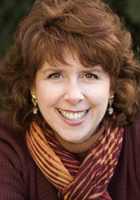
Principal Consultant of Marketing Possibility and also known as the Social Marketing Diva, Kathryn blends social media with core business strategy to create integrated online marketing strategies for small and medium-sized businesses. She specifically focuses on leveraging the vision and value at the heart of the business into quality customer relationships and conversations. She applies over 17 years of experience in high tech marketing and sales to her marketing consulting business with medium and small businesses in the Silicon Valley area. She helps businesses clarify their brand and business persona to use in building conversations with customers and prospects through social networking. She also develops social media marketing plans, teach all aspects of engaging online, and can conduct online campaigns for clients. She has spoken at conferences, workshops, meetings, and corporations on topics ranging from the future of marketing and social media to the application of high availability systems in the financial industry. She teaches Marketing Strategies for Entrepreneurs and Small Business Owners at UC Berkeley Extension San Francisco several times a year, is the President of the Stanford Entrepreneurs Alumni Group, Founder of WomenLaunch, and leads the NorCal BMA Marketing Strategy Roundtable. She has held marketing and sales leadership positions at IBM, Amdahl, Stratus, and Tandem and has served in executive roles on non-profit boards and community organizations. She has a Masters in Philosophy from Stanford University, a BS in Mathematics from William and Mary, and an MBA from Santa Clara University.

Mark Willaman is founder and president of Fisher Vista, LLC, the owners of HRmarketer.com, SocialEars.com, Fisher Vista Marketing Group, HRVendor Phonebook, SeniorCare Marketer, and ShirleyBOARD.com. Mark has nearly twenty years experience B2B marketing, including being a pioneer in the use of web-based technologies for the delivery of HR services. Mark has a track record of conceptualizing and implementing innovative, creative and highly effective marketing campaigns targeting human resource and other B2B decision makers. Mark also has extensive expertise in developing web-based software applications including HRmarketer.com and most recently, SocialEars – proprietary algorithm that analyzes the online “social” activity in the HR and B2B marketplaces, the trending topics and the key influencers driving these discussions. Mark received his BSBA in Marketing from the University of Denver where he was a three-year letterman in Lacrosse, and his MBA from Pennsylvania State University where he was an appointed member of the MBAA Honor Council for two consecutive years. Mark is also a published author and speaker on various marketing topics, and a regular contributor to the HRmarketer Blog. In his spare time, Mark enjoys training for triathlons.

Paul Cowie is a partner in the Labor and Employment Practice Group in Shepperd Mullin’s Palo Alto office. Mr. Cowie represents employers in the full range of employment matters, with his focus on litigation and class actions. Mr. Cowie specializes in litigation avoidance counseling and has successfully reduced client’s litigation docket to zero many times. Mr. Cowie’s experience includes litigating and advising on matters involving all forms of discrimination, harassment, and retaliation; wrongful termination; wage and hour disputes and compliance; independent contractor status; reductions in force; workplace investigations; discipline; grievance; whistleblower claims; workplace violence; and Labor Code violations. Mr. Cowie practices in both state and federal court, and represents employers in all forums.
Before practicing in the US, Mr. Cowie practiced in the UK for approximately five years, representing and advising employers at all stages of employment litigation, including as lead counsel in UK Employment Tribunals. Mr. Cowie’s UK experience means that he has drafted hundreds of employment contracts, dozens of settlement agreements, negotiated warranties and indemnities in corporate transactions and is very familiar with the challenges faced by US-based companies operating or expanding into in the UK.
Pre-Registration Tickets ($20) – on SALE NOW!
6/1/2011: The Culture of Trust, Innovation Tools and the Social Web.
This event explores the value of trust in the highly connected world. We also discussed how innovation tools have put us in closer contact with one another and how they have changed the structure and hierarchy of project developing.
What is the current state of innovation tools? Is the best way to create a breakthrough still a skunkworks project? Or have collaboration and innovation tools reached a level of sophistication where they provide a sensible alternative to the old school method? How does social media factor in?
Read more




